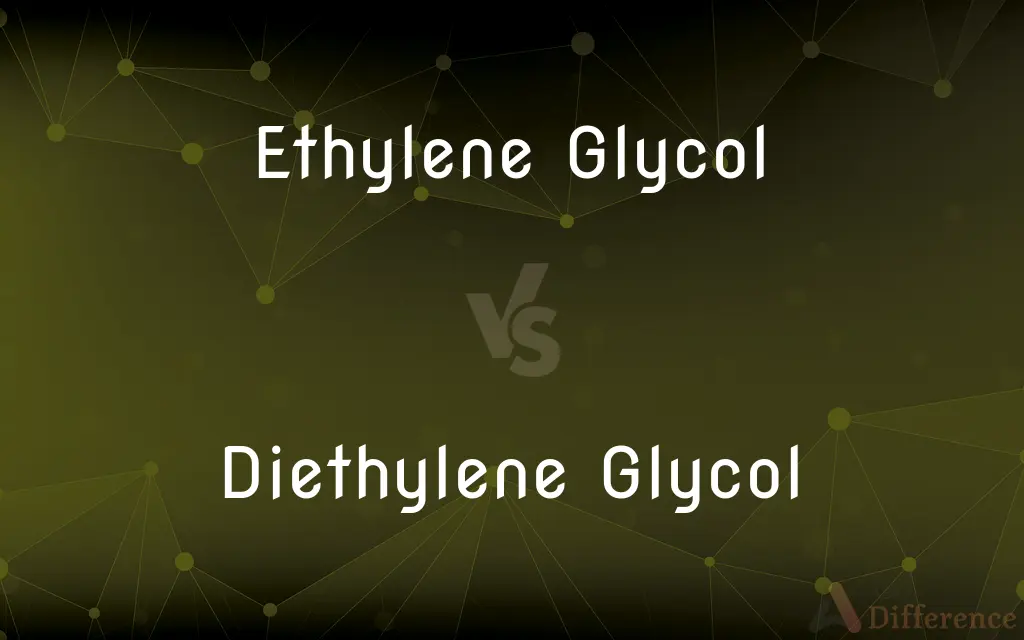Ethylene Glycol vs. Diethylene Glycol — What's the Difference?
Edited by Tayyaba Rehman — By Maham Liaqat — Published on July 28, 2024
Ethylene glycol is a primary ingredient in antifreeze with high toxicity, while diethylene glycol, a related compound, is less toxic and used in a wider range of applications including as a solvent.

Difference Between Ethylene Glycol and Diethylene Glycol
Table of Contents
ADVERTISEMENT
Key Differences
Ethylene glycol (EG) is a simple, colorless, odorless, and sweet-tasting organic compound widely used in antifreeze formulations and industrial applications. It is highly toxic to humans and animals, even in small quantities, leading to acute poisoning and potentially fatal consequences. On the other hand, diethylene glycol (DEG) is a related chemical compound that is produced by the partial hydrolysis of ethylene glycol. Though still toxic, DEG has a lower toxicity level compared to EG, making it somewhat safer for use in various industrial applications.
EG's primary use is in the manufacture of antifreeze and de-icing solutions for vehicles and aircraft, due to its ability to depress the freezing point of water. It is also used in hydraulic and brake fluids. Conversely, DEG is used in a broader range of applications, including as a solvent for dyes, in the manufacture of brake fluid, and in some cases, as a humectant in tobacco, glue, and cosmetics, showcasing its versatility beyond just antifreeze and de-icing solutions.
The toxicity of EG is a major concern, as ingestion of even small amounts can cause serious health issues, including kidney failure, neurological damage, and death. Its sweet taste can unfortunately lead to accidental ingestions, particularly by children and pets. DEG, while also toxic, tends to cause less severe acute health effects, but exposure or ingestion in larger quantities can still lead to serious health complications, including renal failure and neurological damage.
In terms of chemical structure, EG is the simplest diol (a compound with two hydroxyl groups), consisting of two carbon atoms connected by a single bond, each bonded to a hydroxyl group. DEG is formed from two EG molecules joined together, resulting in a slightly more complex structure with four carbon atoms and two hydroxyl groups. This structural difference accounts for their varying physical properties and applications.
While both compounds are used in the production of polyester fibers and resins, EG is particularly crucial in the manufacture of polyethylene terephthalate (PET) used for plastic bottles and containers. DEG, due to its lower volatility and higher boiling point compared to EG, finds use in applications requiring a stable and less volatile solvent, including certain types of brake fluids and as a conditioning agent in textiles and paper.
ADVERTISEMENT
Comparison Chart
Primary Use
Antifreeze, de-icing
Solvent, humectant, brake fluid
Toxicity
Highly toxic
Less toxic than EG
Applications
Antifreeze, polyester production
Dyes, tobacco, cosmetics
Chemical Structure
Simple diol
Two EG molecules linked
Boiling Point
Lower
Higher
Compare with Definitions
Ethylene Glycol
Used in the production of polyester fibers and plastics.
Ethylene glycol is a key component in PET bottle manufacturing.
Diethylene Glycol
Less toxic than ethylene glycol but still hazardous.
While safer, diethylene glycol exposure requires caution to avoid health risks.
Ethylene Glycol
Can depress the freezing point of water.
Ethylene glycol is added to water in solar water heating systems to prevent freezing.
Diethylene Glycol
A compound used as a solvent and humectant.
Diethylene glycol is used in the pharmaceutical industry to improve the solubility of drugs.
Ethylene Glycol
Highly toxic when ingested, causing severe health effects.
Accidental ingestion of ethylene glycol requires immediate medical attention.
Diethylene Glycol
Used in the production of polyurethanes and plasticizers.
Diethylene glycol is a versatile chemical used in various manufacturing processes.
Ethylene Glycol
Acts as a coolant and heat transfer agent.
Ethylene glycol is found in the coolant system of most vehicles.
Diethylene Glycol
Employed in brake fluid and as a conditioning agent.
Diethylene glycol is a component in some brake fluids due to its high boiling point.
Ethylene Glycol
A colorless, odorless liquid used primarily in antifreeze.
Ethylene glycol is essential for preventing a car's engine from freezing in winter.
Diethylene Glycol
Can be used as a moisturizer in cosmetics and tobacco.
Diethylene glycol helps to maintain moisture in cosmetics, preventing them from drying out.
Common Curiosities
Can diethylene glycol be used as an antifreeze?
Yes, it can be used in antifreeze formulations but is more commonly found in applications requiring a less toxic solvent.
What is the main difference between ethylene glycol and diethylene glycol?
The main difference lies in their toxicity levels and range of applications; ethylene glycol is more toxic and primarily used in antifreeze, while diethylene glycol is less toxic and has broader industrial uses.
Why is diethylene glycol considered less toxic than ethylene glycol?
Its molecular structure results in a slower metabolism and less severe acute toxicity, though it is still harmful.
Why is ethylene glycol used in antifreeze?
Its ability to depress the freezing point of water and high boiling point makes it ideal for preventing freezing and overheating in engines.
Are there any safe alternatives to ethylene glycol in antifreeze?
Propylene glycol is a safer alternative used in some antifreeze formulations.
How can exposure to these chemicals be treated?
Treatment involves supportive care and specific medical interventions like fomepizole or ethanol to inhibit toxic metabolite formation, along with hemodialysis in severe cases.
Why do these chemicals have a sweet taste?
Their chemical structure imparts a sweet taste, which unfortunately can lead to accidental ingestions.
Is diethylene glycol safe in cosmetics?
It is used in small quantities as a humectant, but safety depends on the concentration and context of use.
How do these compounds affect the environment?
If not disposed of properly, they can contaminate water and soil, posing risks to wildlife and the ecosystem.
Are there regulations for using these compounds in products?
Yes, there are regulations and guidelines to limit exposure and ensure safe use in products.
Can ethylene glycol and diethylene glycol be found in household products?
Yes, they are found in a variety of household and industrial products, highlighting the need for careful handling and storage.
Can either compound be safely ingested?
No, both compounds are toxic and should not be ingested.
What precautions should be taken when handling these chemicals?
Use protective gear, work in well-ventilated areas, and follow all safety guidelines to minimize exposure risks.
How is diethylene glycol produced from ethylene glycol?
Diethylene glycol is produced by the partial hydrolysis of ethylene glycol, involving the chemical reaction of ethylene glycol with water.
Share Your Discovery

Previous Comparison
Beats Studio 2 vs. Beats Studio 3
Next Comparison
Adoption vs. GuardianshipAuthor Spotlight
Written by
Maham LiaqatEdited by
Tayyaba RehmanTayyaba Rehman is a distinguished writer, currently serving as a primary contributor to askdifference.com. As a researcher in semantics and etymology, Tayyaba's passion for the complexity of languages and their distinctions has found a perfect home on the platform. Tayyaba delves into the intricacies of language, distinguishing between commonly confused words and phrases, thereby providing clarity for readers worldwide.













































